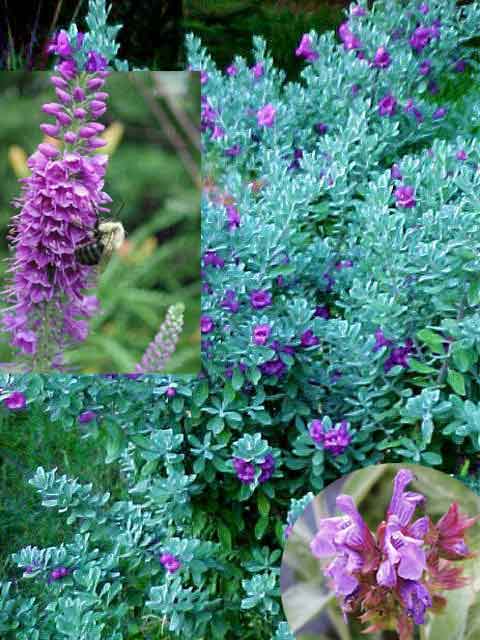
To the Ancients, Sage was sacred ... salvia means the Savior
Sage
"The desire of sage is to render man immortal," instructs a late medieval treatise. Indeed, the sage plant has been praised highly throughout history and on many continents for its power of longevity.
"How can a man grow old who has sage in his garden?" is the substance of an ancient proverb much quoted in China, Persia and parts of Europe. In the 17th century it was so valued by the Chinese that Dutch merchants found the Chinese would trade three chests of Chinese tea for one of sage leaves.
The name salvia, from the Latin salvere — meaning to be in good health, to cure, to save — reflects its benevolent reputation. To the Romans it was a sacred herb, gathered with ceremony. The appointed person would make sacrifices of bread and wine, wear a white tunic and approach well washed and with bare feet. Roman instructions advised against using iron tools, a sensible edict as iron salts are incompatible with sage. The Ancients called sage sacred; salvia also means the savior.
 |
A long time ago the American Indian peoples learned that nature has its own language, and they discovered sage as a purifying herb. Grandmother Sage, or sagebrush, is known as the "Spirit Caller" and embodies the spirit in you, and those you invite to your home. Sister Sage or broadleaf sage is used in the cleansing and purification of your immediate environment and your aura. These sages are to be used only externally, for burning, smudging, aromatically or as ritual decorations. |
Garden sage is a powerful healing plant and a strong culinary herb, often best used on its own. As one chef wrote, "In the grand opera of cooking, sage represents an easily offended and capricious prima donna. It likes to have the stage almost to itself." It is valuable as an aid to digesting fatty foods, both savory and sweet.
Sage is also a beautiful aromatic shrub, popular with bees yet often undervalued as a flowering garden plant.

Sage can be used in many beneficial ways:
Decorative - Attractive wreaths and nosegays can be fashioned using sage leaves.
Culinary - Scatter in salads, infuse ground sage flowers to make a light soothing herb tea. Dip and fry whole leaves in batter or young leaves in cream, and eat with sugar and orange. You can make sage vinegar and butter.
Cleansing - Put dried leaves among linen to discourage insects. Burning sage in an Abalone shell or used as a smudge stick will purify your environment.
Cosmetic - Use in facial steams, astringent cleansing lotions, and as a rinse to condition and darken grey hair. Rub on your teeth to whiten, and as a mouthwash.
Medicinal - Aids digestion. Sage is an antiseptic, antifungal, and contains estrogen. Helps combat diarrhea. Reduces sweating, sooths coughs and colds.
Since ancient times, sage has dried breast milk, stopped menopausal sweating, and eased the minds, wombs and bellies of women everywhere. There is no other herb so effective at drying up the flowing springs of perspiration that gush with some women’s hot flashes.
Use garden sage (Salvia Officinalis) during menopausal years to
Eliminate night sweats, cold sweats and hot flash sweats
The effect is generally noticeable within two hours and can continue for a day or more from a single dose.Regulate hormonal change
Sage’s estrogenic effects have long been noted; our oldest foremothers used it to increase fertility. Sage contains flavoniods and phytosterols.Ease irritated nerves, banish depression
Mineral-consolidating sage is rich in mellow calcium, calming magnesium, peppy potassium, sexy zinc, and anti-stress thiamine.Relieve dizziness, trembling and emotional swings
Sweating doesn’t remove toxins from the body, but it does remove minerals. When you sweat profusely, the mineral loss can cause dizziness, trembling, emotional swings and even joint pain. Sage not only stops sweating and the resulting mineral loss, its rich mineral reserves help you make up for previous depletion.Eliminate headaches
Sage contains headache~easing saponins which keep the blood flowing freely; carotines which nourish the liver and essential fatty acids which keep the blood vessels flexiable.Relieve menstrual cramps and flooding
Sage’s antispasmodic oils and sweet-stopping tannins exert their influence all the way to the uterus, giving you prompt relief from pain and excess bleeding.Dosage:
1–2 spoonfuls of dried leaf infusion, 1–8 times a day
15–40 drops of fresh leaf tincture, 1–3 times a week
Caution: Sage can be toxic when taken internally in large doses for long periods of time. The essential oils in sage can accumulate in the liver and kidneys. Internally, DO NOT USE sagebrush / desert sage, (Artemisia tridentata). DO NOT USE if you have a dry mouth or dry vaginal tissues.
One who is wise is a sage ...
Learn more about sage ~ Links
Native American
Herbs
(includes audio)
|
Thank You for Your Heartfelt |
Secret Garden~Lavender
Secret Garden~Rosemary
Secret Garden~Daffodil Magic
Healing Miracles~Flower Power
Native American Herbs
Secret Garden
Healing Arts
Earthly Delights
Linkups~SouledOut.org's
Recommended Links
Glossary of Esoteric Terms & Phrases
SouledOut.org Site Map
SouledOut.org Home
Graphic
credit, top:
"Paradise Goddess " © Gilbert Williams
is from Iasos
Visionary Artists Gallery

